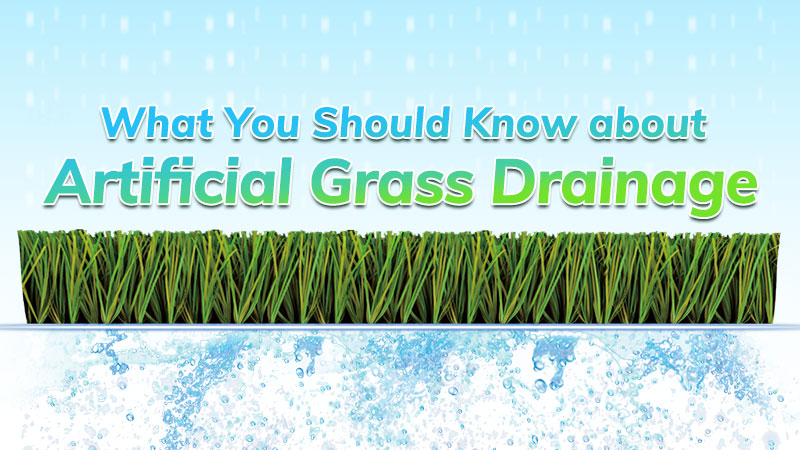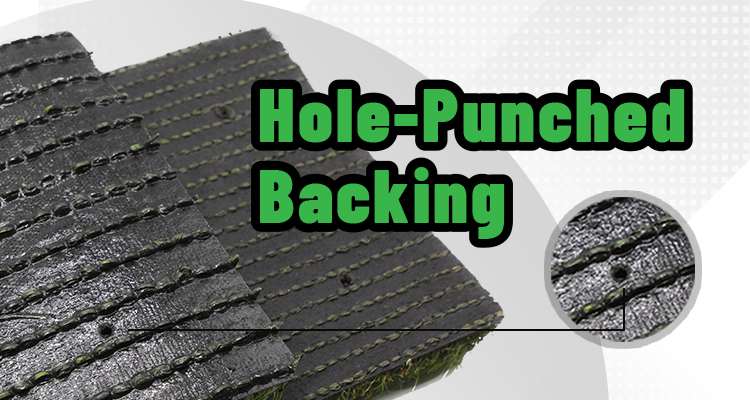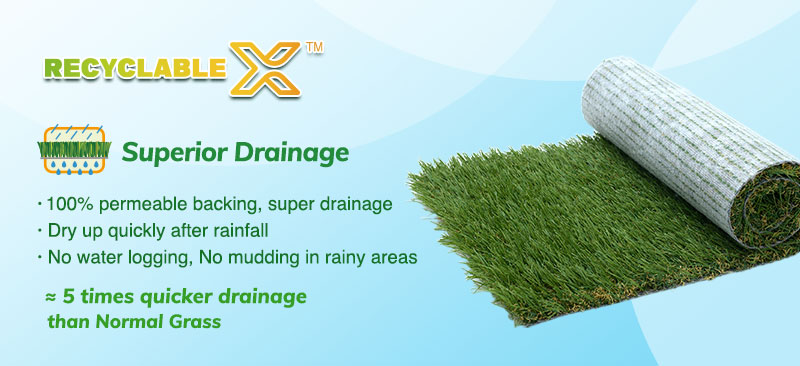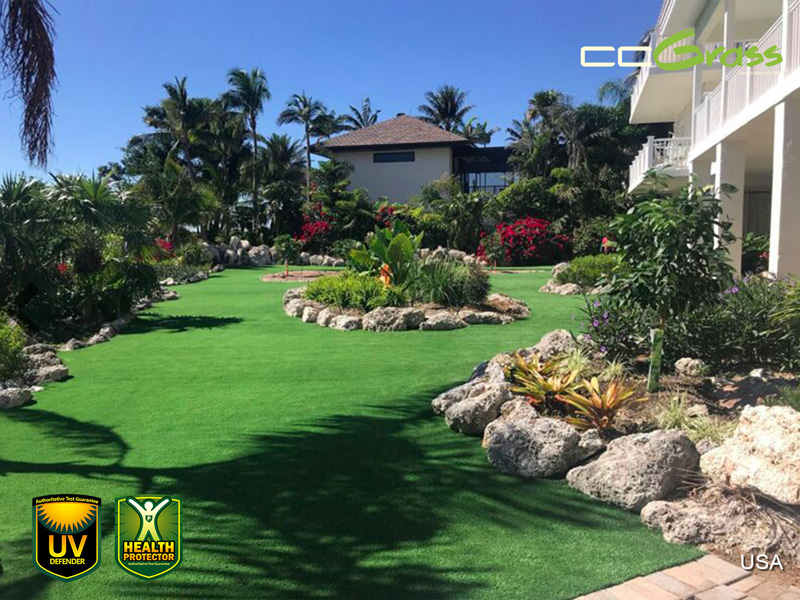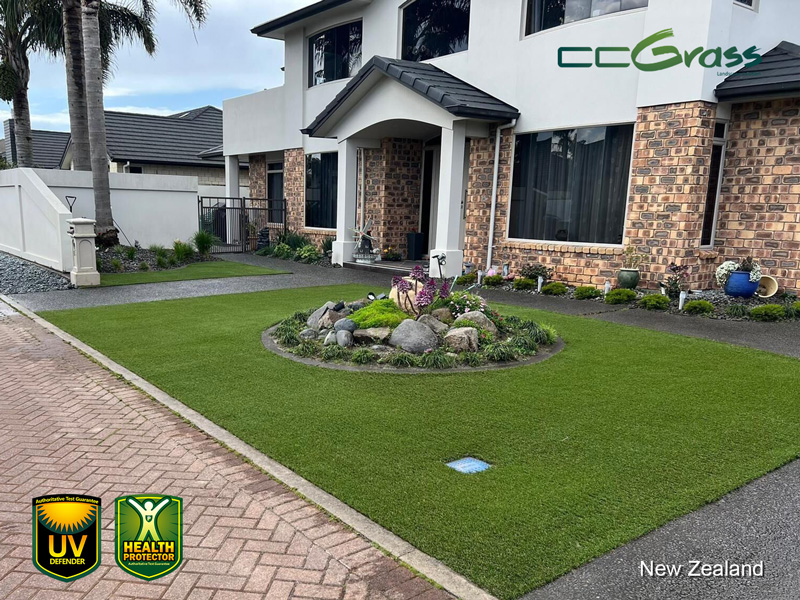What You Should Know about Artificial Grass Drainage
- 03/17/2025
Artificial turf stays green and mud-free in any weather, but how does it handle water? Does it need a separate drainage system?
In this guide, we’ll unpack how synthetic turf handles drainage, highlight what can go wrong, and share simple ways to keep it working smoothly—whether you’re installing on soil or concrete. Let’s get started!
In this article:
How Artificial Grass Drainage Works
Artificial grass is designed with a built-in drainage system, meaning you usually don’t need a separate setup to keep water moving. Unlike real grass, which can bog down as soil compacts, artificial grass efficiently channels water through two key components: the turf backing and the sub-base. Here’s how they work together:
Turf backing: The drainage layer
The backing holds the grass blades and doubles as a water escape route.
- Hole-punched backing
The most common type of astroturf backing is the “Hole-Punched” backing, in which drainage holes run through the turf at equal distances to ensure rapid drainage.
Due to its durability, performance and cost, it has been used for decades and remains one of the most popular types of backing, widely used in gardens, landscapes and patios.
- 100% permeable backing
Another type of backing is 100% permeable and is mostly used for pet lawns or areas that require a lot of drainage. Pet turf drainage is effectively addressed with this specialized backing, facilitating quick urine elimination to avoid odor, stains, and bacterial growth.
- Best drainage artificial grass
Recyclable XTM Series is a revolutionary 100% recyclable artificial grass. Its innovative new backing brings you superior drainage, softness and ultra-lightweight. Recyclable X brings a matchless user experience into the world of landscape grass.
Sub-base: The supporting structure
- Purpose and importance of the sub-base
The sub-base is a vital layer beneath artificial grass, providing stability and aiding drainage. It’s typically essential to prevent issues like pooling or uneven surfaces, though in rare cases with naturally firm, well-draining soil, it may not be needed. For most installations, a sub-base ensures your turf stays smooth and functional over time.
- Materials and installation
Common sub-base materials include crushed granite, stone, or gravel. Installation starts by excavating 3 to 4 inches of soil to make room for a sub-base, typically 2 to 4 inches thick, depending on soil conditions, drainage needs, and usage.
This layer is then compacted into a sturdy, water-permeable base that ensures efficient drainage and long-term stability.
Artificial Grass vs. Real Grass Drainage
Artificial grass drainage outperforms natural grass due to its engineered design:
| Feature | Artificial Grass | Real Grass |
| Drainage Mechanism | Permeable backing + sub-base system | Soil absorption, prone to compaction |
| Drainage Speed & Rate | Fast and consistent, drains 30–1,200 in/hr, product-dependent | Slower, may puddle, drains 5–20 in/hr, soil & maintenance-dependent |
| Maintenance Needs | Low – no need for aeration | Needs aeration and soil care |
| Performance in Rain | Drains quickly remains usable | Muddy, slippery, may require drying time |
Since real grass relies on soil absorption, heavy rain can easily overwhelm its drainage capacity, leading to puddles and muddy conditions. In contrast, synthetic turf provides a more predictable and efficient drainage solution, keeping surfaces dry and usable year-round—ideal for rain-heavy or high-traffic areas.
Common Causes of Poor Artificial Turf Drainage
Artificial grass is built to drain water effectively, but real-world issues like improper installation or tricky site conditions can lead to pooling or slow drainage—potentially causing soggy surfaces, mold growth, or even turf damage. Let’s dive into the key reasons this happens and how to spot the warning signs.
Installation errors
- Incorrect infill: Using the wrong type or too much infill—like heavy sand instead of a lighter, permeable material such as silica sand—can block drainage holes in the turf backing, slowing water flow.
- Improper sub-base: Skipping or skimping on the sub-base prep (e.g., not using enough gravel or failing to compact it) creates a weak foundation that traps water instead of letting it pass through.
- Poor planning: Failing to account for the site’s natural slope or water runoff patterns can leave water sitting on the surface.
Site conditions
- Uneven Surfaces: Low spots or dips in the terrain can form natural puddles, even with artificial grass on top.
- Clay Soil: Heavy, clay-rich soil doesn’t drain well, holding water and preventing it from reaching deeper layers. This can overwhelm even a well-designed turf system.
When these issues arise, they’re not a flaw in the artificial grass itself but a sign that the setup or site needs extra attention.
How to Prevent Poor Drainage with Artificial Grass
Preventing drainage issues begins with assessing your site. If your garden or space already has well-draining soil, artificial lawn will likely work seamlessly without much effort.
But if your area has a history of drainage problems, proactive planning with your installation team can make all the difference. Here’s how to ensure optimal drainage and avoid costly fixes.
Professional installation
A professional turf installation tackles drainage challenges with these key steps:
- Check the area: Assess the soil type and identify any existing drainage problems.
- Prepare a strong sub-base: Replace clay or poorly draining soil with a 3- to 4-inch layer of permeable materials like crushed granite, stone, or gravel, then compact it well to prevent settling and ensure water filters through quickly.
- Level the surface: Smooth out uneven spots to eliminate puddles and ensure even water flow.
- Slope it smartly: Add a slight gradient (1-2%) to direct water away from the surface, mimicking natural runoff.
For step-by-step guidance on getting it right, visit our How to Install Artificial Grass page for expert tips and tricks. When done right, this tailored approach eliminates the need for an expensive standalone drainage system in most cases.
When extra drainage is needed
In extreme cases—like areas with frequent heavy rainfall—additional solutions might be worth considering. French drains can redirect water, or a pro might suggest a custom system, though it’s rarely needed.
Artificial Grass Drainage on Concrete
Synthetic grass isn’t limited to soil—it can be installed on hard surfaces like concrete or tile. However, drainage remains a critical factor. Here’s how to ensure water flows properly when laying synthetic turf over concrete.
Assessing existing drainage
Ideally, it should have a slight slope to guide water away naturally. If drainage holes already exist, make sure they stay clear of grass, glue, or debris during installation. If the concrete already drains well, you’re good to go. If water tends to accumulate, you’ll need to improve the drainage.
Solutions for poor drainage
If your concrete doesn’t drain adequately, consider these two practical solutions:
- Create drainage holes: Drill 16mm holes every 0.5-1 meter to let water pass through, and fill them with pea gravel to prevent clogging. This works best for gardens, patios, and outdoor areas where water can drain into the ground.
- Use drainage cells: Place drainage cells under the turf to create an airflow gap that disperses water. This is perfect for balconies, rooftops, and pet-friendly spaces where water can’t drain downward, as it also helps manage pet urine to reduce odors and bacteria.
Related article: Everything You Should Know about Installing Artificial Grass on Concrete
Conclusion
In conclusion, artificial grass drains water well when installed right. Assess your site, build a solid sub-base, and tackle any drainage issues early to enjoy a dry, hassle-free lawn all year. A little preparation now saves big headaches later.
If you are interested in our 100% permeable synthetic turf products or have any other confusion about artificial grass drainage and installation, please feel free to call us at 86 25 6981 1666 or email us at [email protected].



